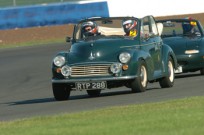Could well be. I was making an educated guess based on distant memory of such things in the 70s.oliver90owner wrote: ↑Thu Sep 26, 2019 11:57 pm I think one will find the ind. bulb is 2W? Current will be according to Ohm’s Law. Approx 1/6 amp.
Different reading on battery condition gague
Forum rules
By using this site, you agree to our rules. Please see: Terms of Use
By using this site, you agree to our rules. Please see: Terms of Use
- geoberni
- Minor Legend
- Posts: 4403
- Joined: Fri Aug 04, 2017 11:19 am
- Location: North Leicestershire
- MMOC Member: Yes
Re: Different reading on battery condition gague
Basil the 1955 series II


-
oliver90owner
- Minor Legend
- Posts: 1810
- Joined: Thu May 12, 2016 6:33 am
- MMOC Member: No
Re: Different reading on battery condition gague
So was I. I don’t think any of the cluster bulbs were 6W - but I may be wrong.
-
MikeNash
- Minor Addict
- Posts: 801
- Joined: Fri Sep 24, 2004 9:09 pm
- Location: Hurstbourne Tarrant, Andover, Hants.
- MMOC Member: Yes
Re: Different reading on battery condition gague
Referring to Yellowpinky's request above on modern battery chargers, I see that my local Lidl has back for sale under it's label "Ultimate Speed" their own "floating" charger for £13.99. I've used one of these for 2-3 years without trouble.
MikeN.
MikeN.
Morris Minor, the car of the future. One day they will all look like this!
-
IslipMinor
- Minor Legend
- Posts: 2147
- Joined: Mon May 10, 2004 9:10 pm
- Location: Oxford, UK
- MMOC Member: Yes
Re: Different reading on battery condition gague
LED Bulbs?
I changed all the speedo bulbs to LED a while ago, and immediately found that the alternator needed a good blip of throttle (~2,000rpm) to get it charging. Normally I don't bother to do it on initial start, just wait until the car gets moving and the alternator kicks in quite quickly, and looking at the ammeter charges as it should.
I changed all the speedo bulbs to LED a while ago, and immediately found that the alternator needed a good blip of throttle (~2,000rpm) to get it charging. Normally I don't bother to do it on initial start, just wait until the car gets moving and the alternator kicks in quite quickly, and looking at the ammeter charges as it should.
Richard

-
oliver90owner
- Minor Legend
- Posts: 1810
- Joined: Thu May 12, 2016 6:33 am
- MMOC Member: No
Re: Different reading on battery condition gagu
All rotating field alternators (automotive or generating sets) require some magnetism to start them generating, after which they are self energising. With automotive devices, the charge ind. lamp supplies the initial current to provide magnetic flux in the rotor. Larger (modern) stator generating sets utilise residual magnetism in the rotor to initiate generation.
I remember one newly formed company, that started making cheap rotating field generators some 40 odd years ago, having to recall or fix thousands of units (a lot already exported to the far corners of the planet) because they would not self-excite.
The soft iron rotors demagnetised themselves as the generator ran down when the generator was stopped. A small hole was drilled in each rotor and a small permanent magnet fixed in. End of problem.
My large, heavy, rolled steel generator with rotating armature (output via slip rings and brushes) has more than sufficient residual magnetism, within the frame, to initiate generation. I believe it is one reason why armature generators tend to be better, for initial heavy surge current duties like starting motors, than stator generators with electronic AVRs. The latter are likely more efficient and most certainly lighter.

I remember one newly formed company, that started making cheap rotating field generators some 40 odd years ago, having to recall or fix thousands of units (a lot already exported to the far corners of the planet) because they would not self-excite.
The soft iron rotors demagnetised themselves as the generator ran down when the generator was stopped. A small hole was drilled in each rotor and a small permanent magnet fixed in. End of problem.
My large, heavy, rolled steel generator with rotating armature (output via slip rings and brushes) has more than sufficient residual magnetism, within the frame, to initiate generation. I believe it is one reason why armature generators tend to be better, for initial heavy surge current duties like starting motors, than stator generators with electronic AVRs. The latter are likely more efficient and most certainly lighter.